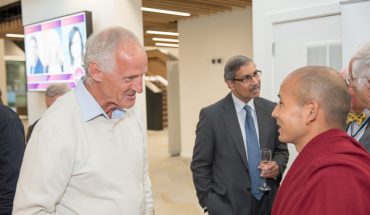When Phillipe Bozzini first designed and used his Lichtleiter in 1803 to peer into the human body, the medical world unwittingly became reliant on observing the endoscopic view of the human body in only two dimensions and this was 35 years before the mechanism of depth perception was even understood. In 1838 Charles Wheatstone was the first to accurately describe and publish the phenomenon of stereopsis – “… the mind perceives an object of three dimensions by means of the two dissimilar pictures projected by it on the two retinae …” He described in his publication how the illusion of light projecting outwards from the surface of a metal plate that had been turned on a lathe had brought him to this realisation. He beautifully demonstrated the validity of his proposed mechanism of stereopsis by creating the Wheatstone Stereoscope. This created an illusion of stereopsis simply by projecting different images to each eye of the viewer. By adjusting each image to give an impression of the perspective that would have been seen by that eye the viewer was left with a sense of a three dimensional image.
For the next hundred years the Wheatstone stereoscope was used to entertain. Even Abraham Lincoln was photographed with a stereo camera so that his three dimensional likeness could be viewed through a Wheatstone stereoscope. All this time medical science was making more and more adventurous explorations into the human body but always in two dimensions. Originally the view was transmitted to a single eyepiece but by the 1970’s the single eye-piece view was being relayed to and transmitted from a television screen as the era of ‘off screen’ operating began.
Laparoscopic surgery really took off in the late 1980’s after the first laparoscopic cholecystectomies were performed. This led to a huge wave of surgical and technological innovations as the benefits and feasibility of minimal access surgery became more universally appreciated. Inevitably with the introduction of a new technology there were new types of complications and hazards for patients. Two important limiting factors were recognised. First was the reduced dexterity and loss of touch associated with long straight instruments and the second was the impairment of depth perception due to loss of stereoscopic viewing. Many attempts have been made to overcome these disadvantages and a variety of different technologies for image capture and image projection have been developed. These systems have been assessed in various research environments with conflicting outcomes on their success and usability.
As early as 1922, surgeon Gunnar Holmgren (1875–1954), Head of the University Clinic of Stockholm for Otolaryngology used a binocular microscope to overcome the lack of depth perception associated with monocular operating microscopes. Binocular microscopes which provided a stereoptic magnified view of the operating field swiftly became adopted by Otolaryngology, Neurosurgery and Orthodontics. However, another 60 years passed before stereo endoscopes were developed.
In the 1980s, a German surgeon, Dr. Gerhard Buess, pioneered Transanal Endoscopic Microsurgery utilising the first ‘stereoendoscope’ with two optical channels, viewed through binocular eye pieces. Such was the quality of the image produced that little has been changed in similar scopes still in use today. Shortly after this efforts were made to attach cameras to a stereoendoscope and project the image onto a specially adapted video monitor which produced a 3D image when viewed through special electronic glasses. This was the birth of 3D videoscopic surgery.
In the laparoscopic setting an image of the operative field may be captured in one of two ways. A traditional rod-lens laparoscope may be used to transmit the light of image from inside to outside the patient where a video camera captures the image as an electrical signal which is sent to an image processor. A newer option utilizes tiny camera chips which capture the operative image at the tip of the laparoscope and an electrical video signal is transmitted along the laparoscope to an image processor. Various 3D systems have been developed and trialed over the past 30 years. They include single channel endoscopes, dual channel endoscopes (true stereoscopes) and the latest ‘insect eye’ scopes. Single channel systems attempt to extract two perspectives of the operative field from a single point of view by splitting the image either with a prism or filter. The result is thus not a true binocular image. Dual channel systems capture two horizontally separated images and thus produce two truly different perspectives of the operative field. ‘Insect eye’ scopes allow for multiple perspectives to be captured and processed simultaneously. There is significant variety in the design of the video capture systems which result is differences in the quality of the image in terms of resolution and image refresh rate.
The projection system aims to deliver a true three-dimensional view to the observer. Although the earliest projection systems seen in cinemas used anaglyph images (different coloured left and right images and coloured filter glasses) the first systems used medically were active shuttering systems. In these systems, alternate left and right views are displayed at high frequency on a screen. The observer wears active shuttering glasses which alternately block out the right or left eye view in synchrony with the screen, Higher quality versions of this technology are still seen with some home 3D televisions. The position of the screen has also been experimented with. Head mounted display systems were tried where each eye was provided with its own screen. The advantage of this is that now filtering of a single projection is required. However, these head mounted systems never took off because of surgeon intolerance. Because the screens move with the surgeons head there is a conflict between the visual cortex and balance centre of the brain. While the horizon of the operative field remains unchanged movements of the surgeons head tell the brain that the horizon should be moving. The resulting occulo-vestibular conflict results in motion sickness.
The modern era of 3D surgery really started with the introduction of surgical robots at the turn of the 21stcentury. The first of these was the Zeus robot created by Computer Motion but now superseded by the DaVinci robot created by the Immersion Corporation. Robots brought two potential advantage to the surgeon. The first was the return of dexterity to the laparoscopic surgical field. Rather than traditional rigid laparoscopic instruments, the robot had instruments that articulated at their end just as the human wrist would articulate. The second advantage was the return of stereopsis. The robot has a dual screen projection system, where each eye is provided with its own screen. Because the surgeon is able to sit at a console with his head in a fixed position there is no occulo-vestibular conflict. Consequently surgeons can sit for many hours in complete comfort looking at the highest quality stereoscopic images. At around the same time a new projection technology was developed by the entertainment industry to allow the projection of high quality 3D images in the cinema the best known of which is the epic Avatar. The concept did away with the need for cumbersome electronic shuttering glasses and replaced them with light inexpensive glasses containing simple polarizing filters. A high definition image is made up of 1080 horizontal pixel lines. This technology relied upon the projection of an image where the odd horizontal pixel lines emitted light polarized vertically and even lines emitted light polarized horizontally. The glasses worn by the cinema goer filtered even lines to one eye and odd lines to the other. If the odd lines contained the left eye image and the even lines the right eye image then the observer perceives a 3D image. Of course the horizontal resolution is reduced by half to 540 pixel lines, but the vertical resolution remains full high definition and the resulting image remains high quality. When this technology was transferred from cinema projection systems to television monitors the opportunity to use these systems in the operating theatre became available. The first prototype of such a system was made by a company called Solid Look and was used to perform a cholecystectomy in the UK in 2010. For the first time an image was presented to a surgeon on a screen in the same way as it would be for any standard laparoscopic operation but with a comfortable high quality 3D image. Research work on these systems has consistently shown that surgical performance is more efficient in terms of time and errors. Within a few years nearly every manufacturer of standard laproscopic systems was producing its own 3D system and this year will see the introduction of some second generation systems that have further improved the quality and comfort of the image. A new era of surgical imaging has been born that looks set to improve the quality and safety of surgical care.
- Combination of drugs could prevent thousands of heart attacks - 21st April 2025
- UQ Study Links Poor Teen Diets to Heavy Social Media Use - 21st April 2025
- Gut microbiome could delay onset of type 1 diabetes - 3rd April 2025






